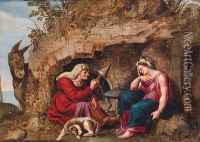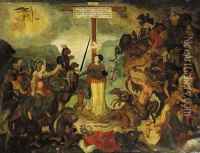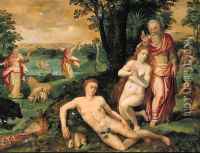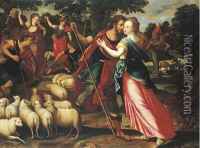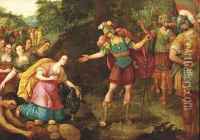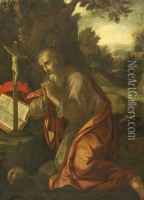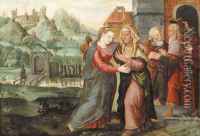Maerten De Vos Paintings
Maerten de Vos was a prolific Flemish painter active during the late sixteenth century, a period that bridged the Renaissance and the early Baroque. Born in Antwerp in 1532, de Vos was deeply influenced by the Italian Renaissance, and his work often reflects the integration of Italian techniques and motifs with Northern European artistic traditions.
After an initial training period with his father, Pieter de Vos, Maerten continued his studies under the tutelage of the painter Frans Floris, an artist who had himself been influenced by his time in Italy. In the early 1550s, de Vos traveled to Italy, where he worked in Venice alongside the prominent painter Tintoretto. He also spent time in Rome, where he was exposed to the works of Michelangelo and Raphael, among others. This Italian experience would profoundly affect his later work, particularly in his use of color and composition.
Upon returning to Antwerp around 1558, de Vos became a master in the Guild of Saint Luke, and he established a successful workshop. He received numerous commissions for altarpieces and other religious works, reflecting the Counter-Reformation's demand for such art. De Vos is known for his dynamic compositions and vivid narrative scenes, often filled with a multitude of figures and intricate details. His works are characterized by their vibrant colors and the combination of realistic detail with an often complex and crowded composition.
In addition to his religious paintings, Maerten de Vos also produced allegorical works, portraits, and designs for prints. His two sons, Daniel and Maerten the Younger, were also painters and continued the family tradition. De Vos's legacy was significant in Antwerp, and his workshop contributed to the spread of Flemish artistic styles across Europe.
Maerten de Vos died in Antwerp in 1603. His body of work not only reflects his own skill and vision but also embodies the rich cultural exchange between Italy and the Low Countries during the Renaissance. His influence persisted through the works of those he trained and through the many engravings made after his designs, which helped disseminate his style widely.
